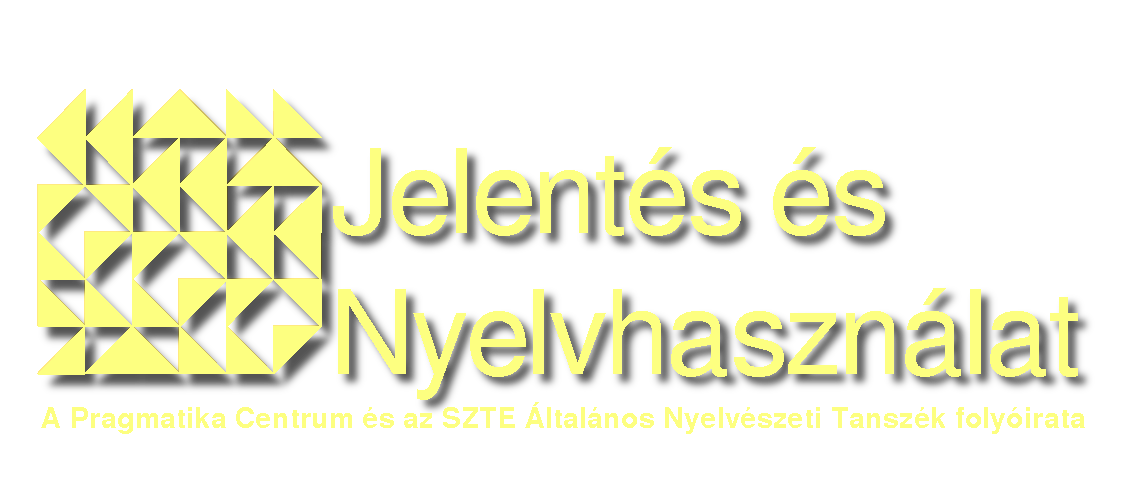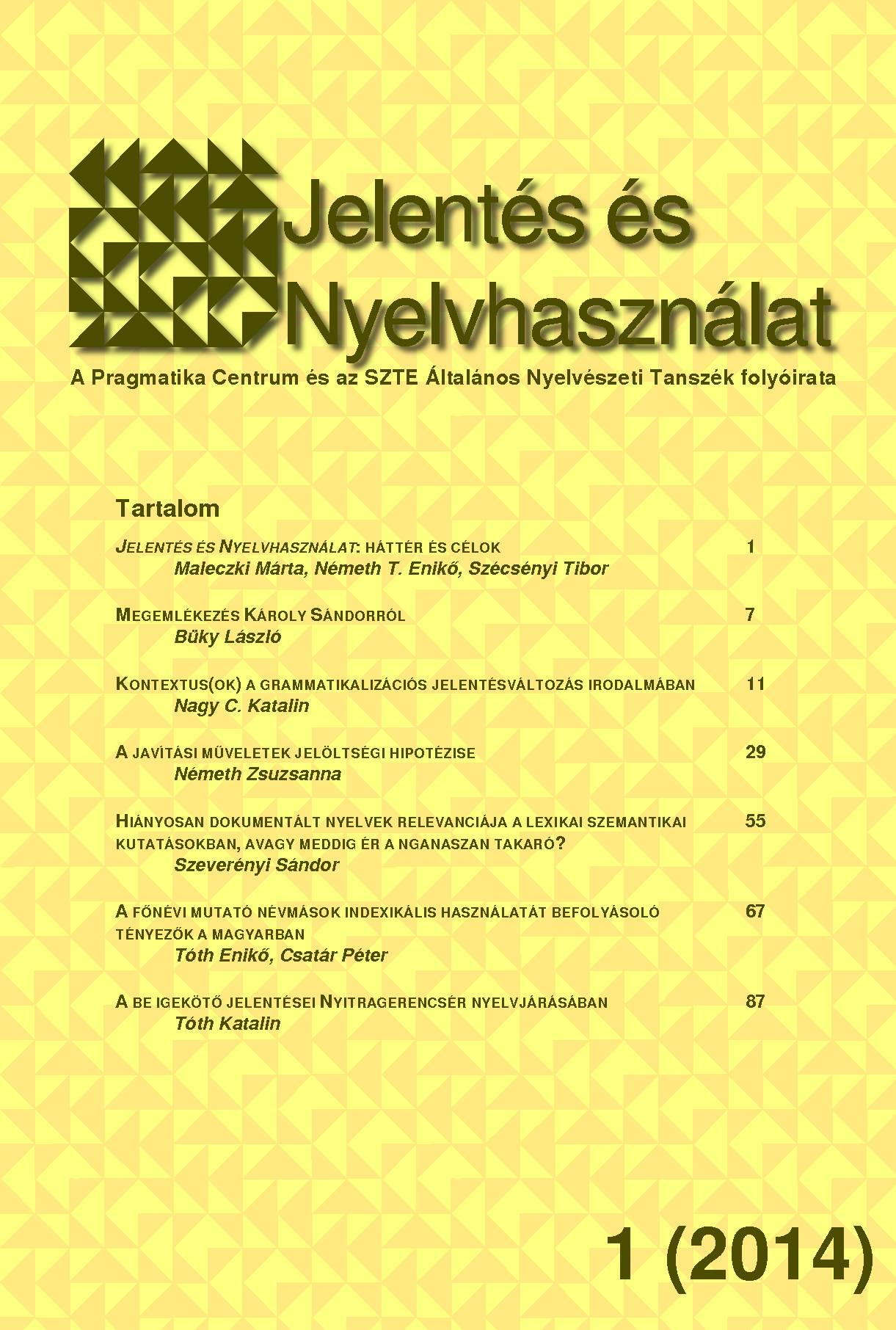Context(s) in the literature on semantic change in grammaticalization
Main Article Content
Abstract
The present paper aims to discuss the notion of context as it appears in historical pragmatics, and, especially, in research concerning semantic change in grammaticalization. It presents the context types provided in Heine (2002) and Diewald (2002), which are supposed to be important in semantic change in grammaticalization. After discussing the characteristics of critical context, proposed in Diewald’s (2002) typology, the paper highlights why the expression context as used in grammaticalization literature cannot be understood as the context of online utterance interpretation. First, this notion of context is narrower than the context of online language processing in the sense that it contains only those contextual features which are important in semantic change. Second, the context in which linguists today interpret historical utterances differs from that one which plausibly could have played a role in utterance interpretation of contemporary language users. Third, the concept of context in the relevant literature reveals a mixture of features of context in utterance interpretation and context as a methodological phenomenon.
Downloads
Article Details

This work is licensed under a Creative Commons Attribution-NonCommercial-NoDerivatives 4.0 International License.
References
Bybee, Joan L. 2005. Mechanisms of change in grammaticization: The role of frequency. In Brian D. Joseph – Richard D. Janda (szerk.) The Handbook of Historical Linguistics Vol. 3. (Blackwell Handbooks in Linguistics). Oxford: Wiley-Blackwell. 602–623.
Cummings, Louise (szerk.) 2010. The Pragmatics Encyclopedia. London, New York: Routledge.
Dér Csilla Ilona 2004. Határok nélkül: a grammatikalizáció státusáról. Nyelvtudományi Közlemények101:182–194.
Diewald, Gabriele 2002. A model for relevant types of contexts in grammaticalization. In Ilse Wischer – Gabriele Diewald (szerk.) New Reflections on Grammaticalization. Amsterdam, Philadelphia: John Benjamins. 103–120.
Dömötör Adrienne 2012. A nyelvtörténeti adat: elvek, gyakorlat, lehetőségek. Magyar Nyelv108/1:39–51.
Evans, Nicholas – David Wilkins 1998. The Knowing Ear: An Australian Test of Universal Claims about the Semantic Structure of Sensory Verbs and Their Extension Into the Domain of Cognition. Köln: Institut für Sprachwissenschaft, Universität zu Köln.
Finkbeiner, Rita – Jörg Meibauer – Petra B. Schumacher (szerk.) 2012. What is a Context? Linguistic Approaches and Challenges. Amsterdam, Philadelphia: John Benjamins.
Fischer, Olga 2004. What counts as evidence in historical linguistics? Studies in Language28/3:710–740.
Fischer, Olga 2007. Morphosyntactic Change: Functional and Formal Perspectives. Oxford: Oxford University Press.
Fitzmaurice, Susan M. – Irma Taavitsainen 2007. Historical pragmatics: What it is and how to do it. In Susan M. Fitzmaurice – Irma Taavitsainen (szerk.) Methods in Historical Pragmatics. (Topics in English Linguistics 52). Berlin, Boston: De Gruyter. 11–36.
Forgács Tamás 1993. Zárt korpuszok és pótkompetencia. Néprajz és Nyelvtudomány35:17–23.
Heine, Bernd 2002. On the role of context in grammaticalization. In Ilse Wischer – Gabriele Diewald (szerk.) New Reflections on Grammaticalization. Amsterdam, Philadelphia: John Benjamins. 83–102.
Hopper, Paul J. – Elizabeth Closs Traugott 1993. Grammaticalization. Cambridge: Cambridge University Press.
Levinson, Stephen C. 2000. Presumptive Meanings: The Theory of Generalized Conversational Implicature. Cambridge: The MIT Press.
Meibauer, Jörg 2012. What is a context? Theoretical and empirical evidence. In Rita Finkbeiner – Jörg Meibauer – Petra B. Schumacher (szerk.) What is a Context?: Linguistic Approaches and Challenges. Amsterdam, Philadelphia: John Benjamins. 9–32.
Nagy C. Katalin 2013. A katalán „anar + főnévi igenév” szerkezet grammatikalizációs jelentésváltozásának kezdeti szakaszáról történeti pragmatikai megközelítésben. Doktori értekezés. Szeged: Szegedi Tudományegyetem.
Németh T. Enikő előkészületben. Interaction between grammar and pragmatics: the case of implicit subject and direct object arguments in Hungarian lan¬guage use. Kézirat.
Németh T. Enikő 1994. Megnyilatkozás: típus–példány. Néprajz és Nyelvtudomány35:69–101.
Németh T. Enikő 1996. A szóbeli diskurzusok megnyilatkozáspéldányokra tagolása. (Nyelvtudományi értekezések 142). Budapest: Akadémiai Kiadó.
Tátrai Szilárd 2004. A kontextus fogalmáról. Magyar Nyelvőr128/4:479–494.
Traugott, Elizabeth Closs 1999. The role of pragmatics in semantic change. In Jef Verschueren (szerk.) Pragmatics in 1998: Selected Papers from the 6th International Pragmatics Conference Vol. 2. Antwerp: International Pragmatics Association. 93–102.
Traugott, Elizabeth Closs – Richard B. Dasher 2004. Regularity in Semantic Change. Cambridge, New York: Cambridge University Press.

